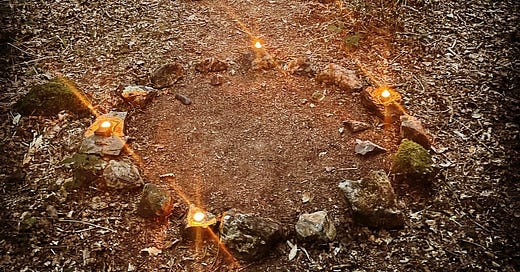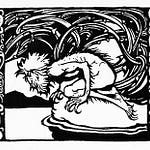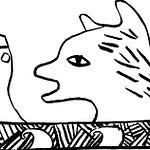I was just preparing for the below interview with Nathanial at Grail Country when I got the news. I’m not expecting you to be a monarchist or even interested in the English royals, but you will understand the tremors when a proper old growth sovereign dies. In an already hugely uncertain moment, England shakes yet again.
So I thought you may simply want to listen to a story. Stories settle our fur back down, they always have. This is a beautiful Saami tale. I did say Substack would be a care-package sometimes.
I recorded it rough by a fire a few weeks ago, a couple of pals listening in. There’s a few notes below. And I enjoyed the below interview: it was also nourishing to speak to Nathanial, even if I was slightly out of focus absorbing the news. I hope you enjoy it - it’s on all sorts of soulful matters, charging around the place, occasionally growing quiet.
Your friend,
Martin
*
Notes on Akanida:
We who die,
And the gods that can’t.
Our inconstancy can be fascinating to the gods. The brief flare up of our years, our pettiness and fidelities all hold their attention. The fleetingness of life is mesmeric. There’s something rather unsexy about eternity. They say the storytellers amongst such deities weave their epics through the disasters and wiliness of our own ebullient narratives. It could be they are bored with their apportioned lot on occasion.
In this story Akanida, a divinity who distributes her father’s warmth, is particularly captivated. In her fascination she finds another way to dish out sustenance, by the rituals and dances she brings to the people. She makes true culture.
It takes a while to develop human patience but she does so, applying herself to the tasks of the hut, even whilst her crafty father has found a way to both honour her wishes and keep her safe for a while. Dads do this kind of thing. A tent with an old couple on a solitary island is hardly Times Square. But this is a world that still has tacit awareness of the divine. She is discreetly recognised by the old woman and allowed to stay under their roof. They are cultivating a mistress of sunbeams.
A question: what arrives in our life that we quietly recognise as holy, and how do we both feed it and raise it?
The story tells us that what arrives needs space and quiet around it. And that over time it needs to be grounded in tasks particular to the lived, human experience. If it elected to show up, then it may need a little tuition in the ways of this world. This happens again and again in these stories. So how does a deity come of age? How can we help a spiritual force mature? Is that even possible? It needs craft, repetition, instruction.
The beginning of the story provokes many questions. There is something delightful about the scene of the old woman and Akanida quietly working on the dress as the old man smiles across at them. In Russian stories there is rumour that a woman needs ten thousand feminine secrets sewn into her wedding dress before she marries. There are both the wiles of the old lady flooding into it, and the vast, generative overview of the heavens at the same time.
So the story dictates its tempo. With the creation of the dress, and the blessing of the old woman, change arrives. Rooted in the feminine, she is brought-by-storm to the masculine, the River of our Fathers. I wonder what such a storm would look like to our daughters. What storm leads them from adolescent to young womanhood?
There is something extraordinary about a deity undergoing a human rite of passage. Not just the rumour of one, or a momentary glimpse, the like of which we see in a young man clad in an antelope robe singing the dusk down, but a full consecrated goddess temporarily in the form of a girl. I think it would be wise in all our rites of passage work to quietly entertain the idea we may be addressing the daughter of the Sun, or the son of the Moon.
A quite different look comes into our eyes when you address a youth with that kind of care, and a tangible, blessing-energy leaps up between you. It’s that moment when a youth is gazed upon as the universe gazes upon them when it is pleased with them, and they themselves witness all of that beholding in your steady eyes. They will have worked hard to get it, pushed past the boundaries they thought themselves capable of and now stand, swooned and delighted and almost heartbroken by the love that now tenderly assails them. Those few minutes will change the trajectory of a life. Not can but will.
Maybe even the gods seek to be witnessed by us, sometimes.
The Saami are delighted to see her, almost too ebullient, so she reveals that she is in the world but not quite of it: they can’t quite lay their excited hands on her. She’s not a plaything. She has much to give, but not in a melee. The rough and tumble of our world needs a little divine organisation, needs to comprehend a boundary or two. There is something childish in their response to her, something that needs education.
What she brings is patterns. Organised, delightful, formal patterns. She brings form. In something of a mirror to Red Bead Woman she distributes a kind of refreshment-through-ceremony to the wider tribe, but in this case, the betrayal of such kindness will come a little later.
From the French caves to a Moroccan mosque to a Hackney synagogue to an Orkney kirk, humans delight in ornamentation as divine celebration, as diverse as the cultures that birthed them. In such places the move from making beauty to being beauty can occur. The making itself makes us beautiful. The strong fingers that invoke the images in an Aboriginal sand painting become part of the dream divining of the creation itself.
But it can’t stay this way, can it? Even when the holy fire moves from tent to tent, showing us how to live. Trouble always lopes in, spitting and sniffing the air, cocking its hind leg. We have to leave Eden and make the best of it out here with the plastic sofas, cheap promises and barbed wire. Where else is there to lay our prayer mat?
SEALING THE SMOKE HOLE
Innocence can never be the whole story. Greed shows up in the so-called elders. The ones who hang out in the damp of the swamp reviving stagnant energies. And let’s confess. Let’s cleave to the dark a little.
Isn’t there some barely comprehended, incy-wincy little part of you that wants to take down the smiling dancing girl? I appreciate it’s not exactly rational, but such an urge sometimes slaps its scaly tail against the wet dungeon wall in the belly of the castle. When we’ve made many crooked deals, when we’ve discreetly betrayed our own values again and again, it hurts when someone rocks up filled with love and light. Even when they are a goddess. Especially when they are a goddess. It makes us uncomfortable, makes us question our decisions, our tacit betrayals, our vicious little land grabs. Every tawdry victory strut we make actually diminishes our stature.
So we slop around in pre-historic muck and grunt angrily to our half- formed gods. We can only dimly make them out, but they are present and correct. They shimmer and hiss. And the advice is to close the smoke hole when you want to do some killing. Close the connection to the divine world. These days, we are doing a pretty good job of achieving such a thing. Even a smartphone can be pretty good distraction as boney hands quickly draw the flap across the smoke hole and break sacred connection. You can have a million concerns, but the connection you most crucially covet will be lost. Once the connection goes it’s quite possible to kill with a stone, and any one of them will do.
To seal the smoke hole is quite a terrifying image. To create invisibility from divine eyes so killing can occur. To break the connection. It is possible for life’s brutality to close the smoke hole in our soul to the heavenly world. And that’s not just a place of the seemingly far away, it’s a place of pine cones and bullish storms and antler-clashed stags among humming dark grasses. It’s vivid and magical and filled with communication.
And for countless thousands of years we have gazed out at the earth or up into the heavens and witnessed presences looking back at us. That maybe even wished us well every now and again. We lose the old arrangement when we seal the smoke hole. Grief becomes despair, wit becomes sarcasm, the world can be measured. Climate change is a direct result of culturally sealing the smoke hole. Not just to some far-distant heaven but the heaven that roams in and around and through us. Seal up the smoke hole and on the deepest, most unconscious level, nothing matters.
Seal up that hole and we become mad. Seal up that hole and the most ruthless of acts can be reasoned into actuality. We become possessed by ourselves, and only ourselves. Every generation has some version of the closing of the smoke hole, but certainly in my life it’s never seemed as absolutely nailed down as it does now. I note how claustrophobic I feel these days, I have to sleep with all the windows open, regardless of temperature, I rip the collar off every t-shirt I wear. Don’t fence me in.
So what do we do? The story gives a two-fold, pretty emphatic directive. You may want to grab your journal.
Attend to your swamp gods that have wicked intent for others and yourself, and stay close to the spiritual patterning that orientates you correctly. The message is hardly startling, hardly new, but I suspect the sermon will remain the same until we actually act upon in. We’d mostly rather skip onto the next groovy idea, than the maybe un-dramatic grind of labouring in these two areas of swamp and sun, soul and spirit, water and fire. Where’s the earth and air? Well, that was in the telling itself. We are bound up with both intensities: the swamp and the sun, but can’t exist entirely in either. That’s for saints, dictators and other high-end troublemakers to exist in.













Share this post